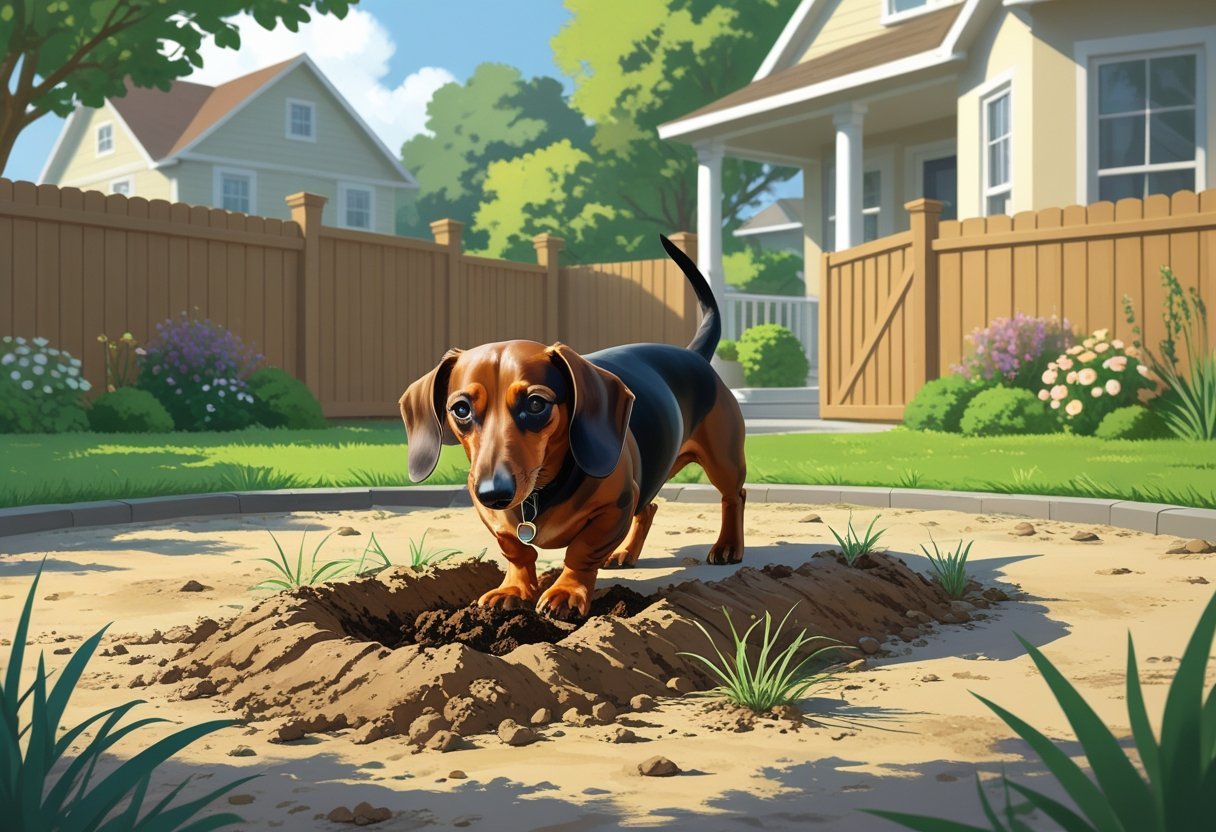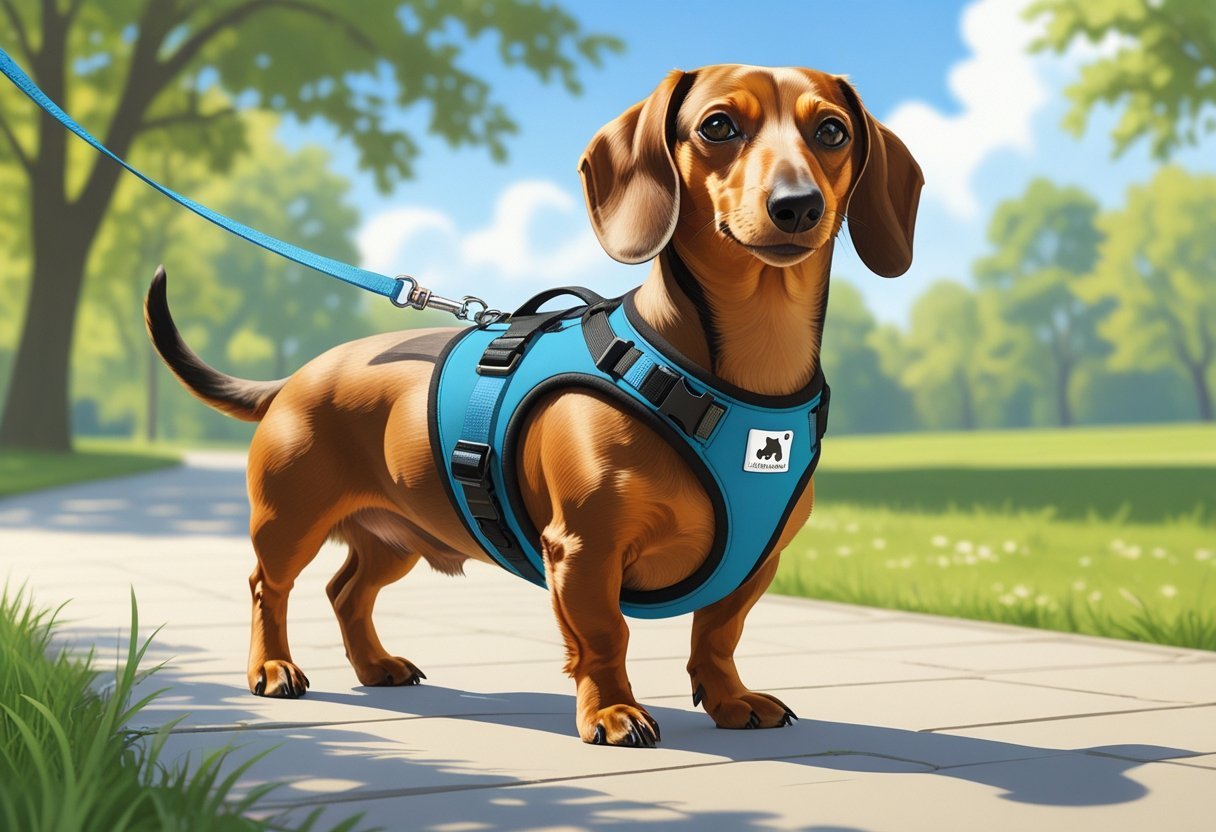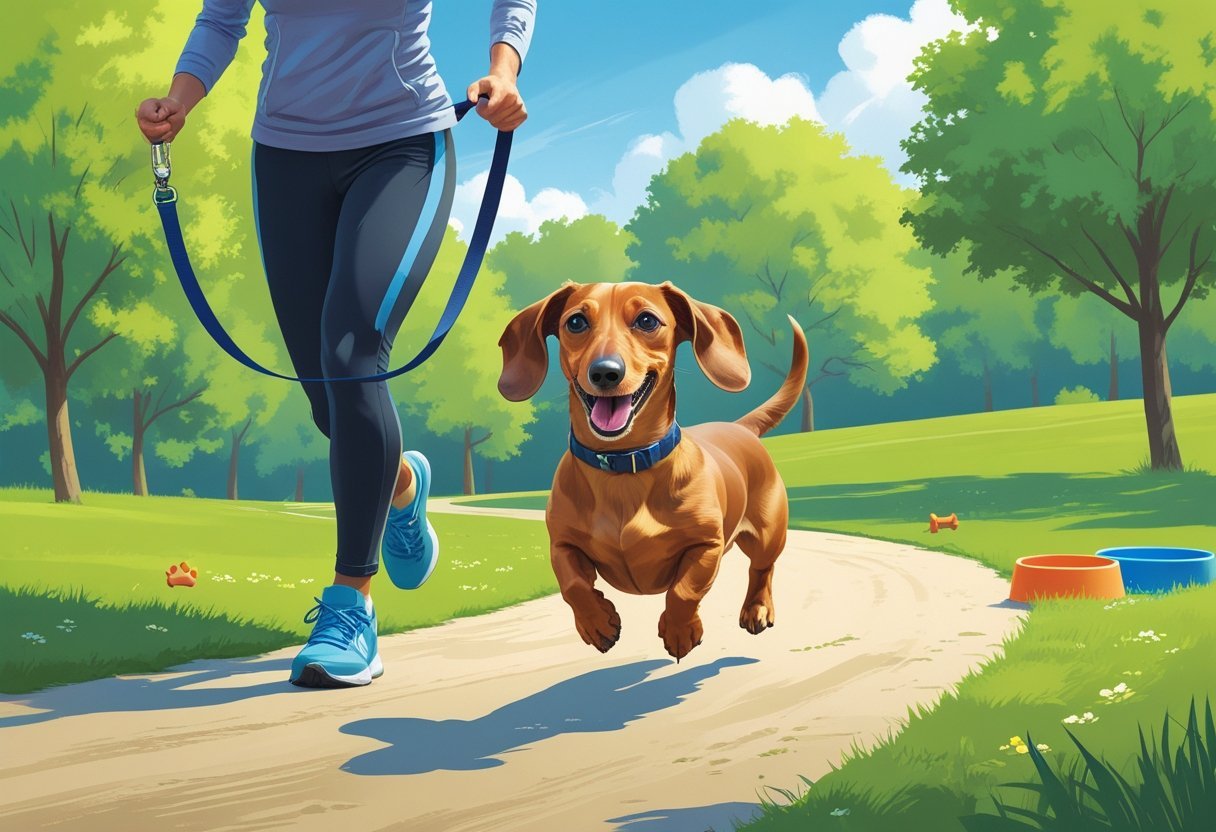Dachshunds come hardwired to dig and burrow, thanks to their roots as badger hunters 🦡. Sometimes, that means your garden gets a little too much attention 🌱 or your couch cushions turn into a makeshift den 🛋️.
Understanding and managing your dachshund’s burrowing behavior is essential 🐾. Effective dachshund burrowing solutions help keep your home safe 🏡 and your pup happy 😊.
Plenty of dachshund owners get frustrated by digging 😩 without realizing there are simple fixes ✨. Your pup isn’t out to destroy things—they’re just following instincts that run deep ❤️.
With the right approach, you can give them healthy outlets for this urge 🐶 and still keep your belongings safe 🛑.
Key Takeaways 📌
- Offer designated digging spots and burrowing blankets to satisfy your dachshund’s natural instincts 🛏️.
- Try positive reinforcement training to redirect unwanted digging to better places 🎾.
- Balance your dachshund’s need to burrow with home protection by giving them enough exercise and enrichment 🚶.
🐾 Free Dachshund Care Guide
Download our free checklist to ensure your Dachshund stays happy, healthy, and well-loved!
Get Your Free Guide 🐶Understanding the Dachshund Burrowing Instinct
Dachshunds are born diggers 🐾. Their urge to burrow comes straight from their hunting background—it’s just in their DNA 🧬.
Origins of Burrowing Behavior 📜
Back in 15th-century Germany, people bred dachshunds to chase badgers and other burrowing animals 🦡. Their name literally means “badger dog” 🇩🇪.
That long body and those strong paws? They were made for digging into tunnels and flushing out prey 🕳️.
Even today, dachshunds carry those instincts, whether they’ve ever seen a badger or not 🐶. Centuries of breeding have left them with a powerful urge to dig, tunnel, and make little dens 🏡.
They don’t really get that your flowerbed isn’t a hunting ground 🌷, or that your blankets aren’t dirt 🛏️. Instinct just takes over sometimes 🔄.
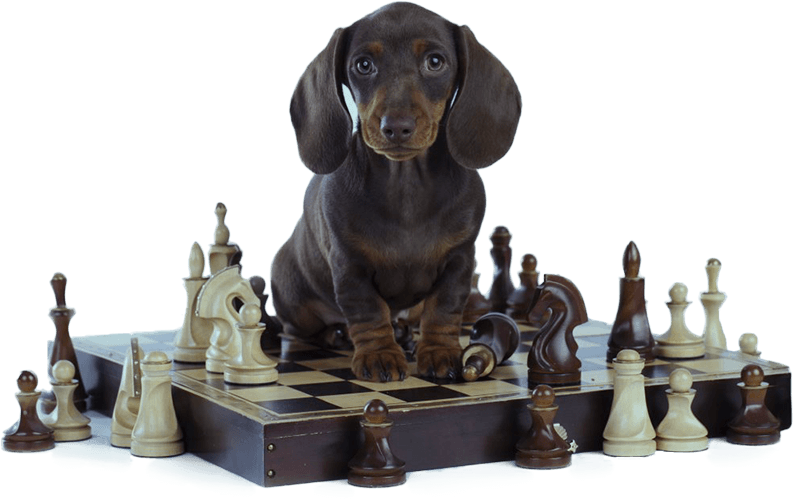
🧠 Brain Training for Dogs – Redirect Digging With Smart Play
Step-by-step games that channel your Dachshund’s natural burrowing instinct into focus, impulse control, and calm indoor play—keeping your pup happy while protecting your home.
- Quick 5–10 minute sessions that teach “leave it” and “no dig” 🐾
- Nosework and puzzles that burn mental energy and reduce digging 🧩
- Indoor-friendly activities that save your couches, rugs, and garden 🏡
Signs Your Dachshund Wants to Burrow 🔍
Physical indicators your dachshund’s in the mood to dig include:
- Pawing or scratching at blankets, pillows, or soil 🛋️
- Circling in one spot, almost obsessively 🔄
- Nudging things with their nose to make a space 👃

You might catch them doing this before settling down for a nap 😴. They’ll burrow under blankets or couch cushions, trying to make a cozy little spot 🌟.
Some dachshunds get visibly excited when they find soft dirt or sand 🏖️. Their body language shifts—a low chest, wagging tail, and that classic focused digging 🐕.
They dig more if they’re stressed or cold ❄️. Burrowing helps them feel safe and warm ❤️.
Benefits and Challenges of Instinctual Digging ⚖️
Letting them burrow in the right places pays off:
- Gives them mental stimulation and exercise 🧩
- Helps reduce stress and anxiety 🌿
- Satisfies instincts, so they’re not frustrated 😊
- Makes them feel secure 🔒
But if you don’t manage it, you might end up with destroyed gardens 🌱 or scratched-up furniture 🛋️. Some dachshunds get so into digging, they start ignoring commands 🙉 or get possessive about their digging spots 🚫.
It’s all about finding that sweet spot—give them healthy ways to burrow, and you won’t have to sacrifice your home or yard 🌼.
Managing Burrowing Behavior at Home
To handle your dachshund’s digging instincts, you’ll need consistency and some well-placed outlets 🐾. Mix positive reinforcement, safe digging spots, and gentle redirection for best results 🎯.
Positive Reinforcement Techniques 🎉
When your dachshund skips digging where they shouldn’t, reward them 🦴. Toss a treat, give some praise, or hand over their favorite toy right after the good behavior 🧸.
Command training helps a lot 📢. Teach “leave it” or “no dig” with clear cues, and always reward them fast when they listen ✅.
More exercise means less boredom digging 💪. Shoot for 30-45 minutes of activity a day—walks, playtime, whatever gets them moving 🚶.
Don’t forget mental workouts 🧩. Puzzle toys, snuffle mats, and training games scratch that hunting itch without wrecking your stuff 🏡.

🌿 Wild Earth Complete Protein Dog Food
- Plant-powered nutrition that supports calmer, steadier energy for training 🙂
- Great in snuffle mats and puzzle feeders to satisfy foraging instincts 🧩
- Gentle on tummies so burrowing stays cozy—not stress-driven 🏡

🥣 ChefPaw Fresh Food Maker (C-PRO)
- Cook fresh, portion-controlled meals that reduce restlessness 🙂
- Prep soft training rewards for “no dig” and redirection sessions ✅
- Customize fiber/texture to keep your Doxie satisfied and engaged 🧩
Designating Safe Burrowing Zones 🛏️
Set up a digging box 📦. A kid’s sandbox or a big plastic tub with loose soil or sand does the trick. Bury a few toys or treats to make it interesting 🎁.
Put the box somewhere shady outside 🌳, especially if that’s where your dog already tries to dig. Show them it’s their new digging spot by hiding treats and letting them see you do it 👀.

Inside, try deep blankets, special burrowing beds, or even a blanket box 🛋️. These give them a place to nest without trashing the furniture 🪄.
Make your designated area the most fun spot 🎊 by adding new scents or toys now and then. Keep it fresh so they keep coming back 🔄.
Discouraging Unwanted Behaviors 🚫
If you catch them digging somewhere off-limits, interrupt with a calm “no” and guide them to the right spot 🙅. Punishing them after the fact won’t work—they won’t get why you’re upset ❌.
Block off favorite forbidden zones with barriers like rocks, small fences, or big planters 🪴.
Use pet-safe deterrents on problem areas 🌿. Bitter sprays, citrus peels, or a little vinegar-water can make those places less appealing 🍋.
Try textured mats or grids in the garden to make digging uncomfortable but safe 🧱. They’re especially handy around fences if you’re worried about escapes 🏞️.
Protecting Your Home From Damage
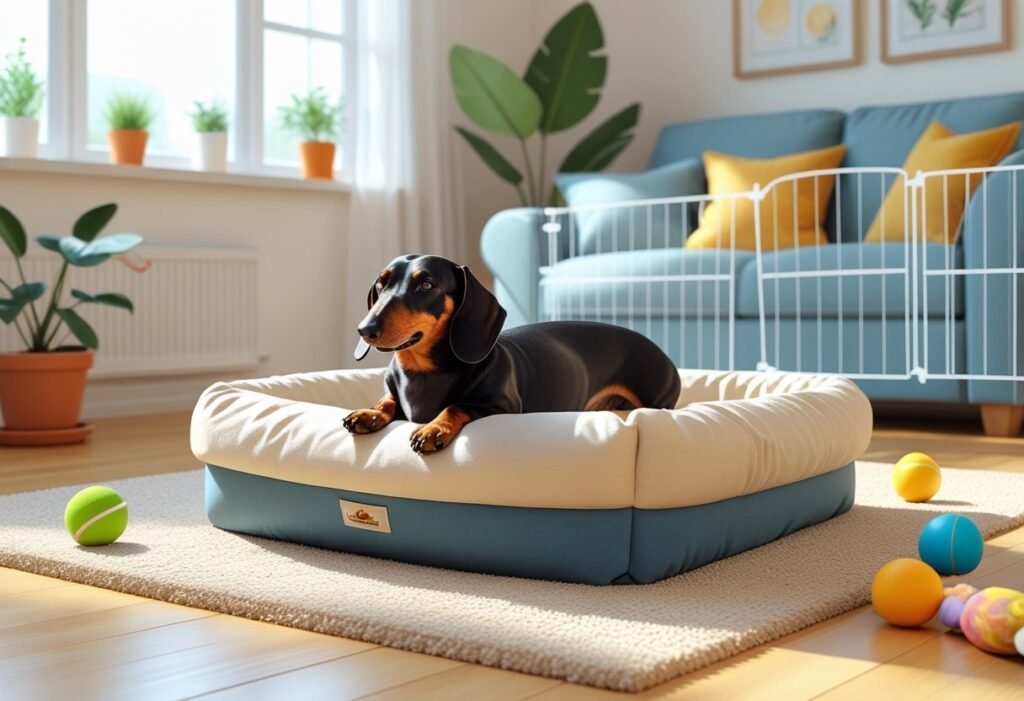
Dachshunds adore digging and burrowing 🐾, but that can spell trouble for your home and garden 🏡. With a few smart tricks, you can keep your place looking good and your dog satisfied ✨.
Home-Proofing Tips for Doxie Owners 🛋️
First, figure out where your dachshund loves to dig most 🔎. Couches, beds, and carpet corners are common hotspots. Block these off when you can’t keep an eye on them 🚫.
Try deterrent sprays on furniture edges 🌿. They smell bad to dogs but won’t hurt them ✅.
Baby gates work wonders for keeping your dog out of rooms with breakables or fancy furniture 🚪. It’s a relief not having to worry every time you leave the room 😌.
Give them alternatives 🎁. Toss designated blankets in their favorite corners for nesting. Swap out the blankets now and then to keep things interesting 🔄.
Pick up furniture covers that you can wash easily 🧺. Your furniture stays protected, and your dachshund still gets to burrow 🐶.

⏲️ Petlibro Auto Feeder
- Predictable meal times to calm routine-driven diggers 🙂
- Small, frequent portions to curb scavenging and carpet digging ✅
- Pair with dig boxes/snuffle mats after meals to channel instincts 🧩

🛡️ The Swiftest Pet Insurance Comparison Tool
- Compare plans with coverage for yard mishaps and escapes 🙂
- Plan ahead for IVDD and injury bills while you train calmly ✅
- Save time and budget more for enrichment gear 🧩
Common Household Risks to Watch ⚠️
Dachshunds target certain things when they’re in a burrowing mood:
- Cushions and pillows – often torn up for nesting 🛏️
- Carpets and rugs – corners get pulled and frayed 🪞
- Bedding – sheets and comforters are prime burrowing real estate 🛌
- Garden areas – outdoor digging can ruin landscaping 🌱
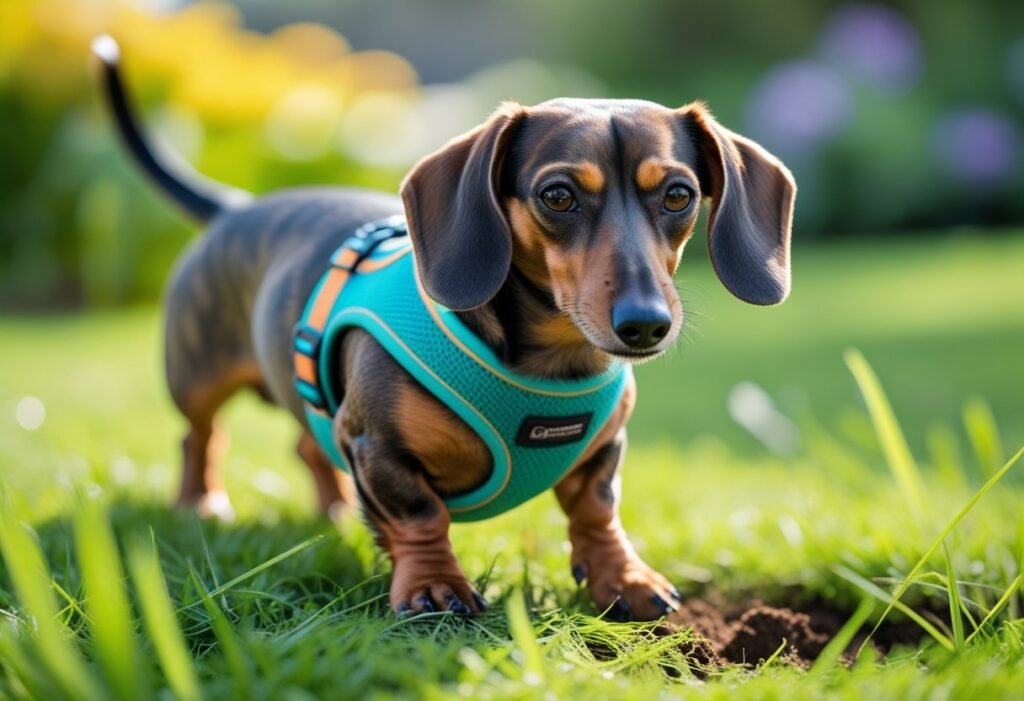
Check your stuff regularly for early signs of damage 🔍. Scratches, loose threads, or tiny tears can get worse fast ⚡.
Watch spots where your dachshund hangs out alone 👀. Sometimes, separation anxiety makes them dig more 😟.
If nothing else works, consider temporary crating when you’re gone 🪄. It keeps both your dog and your home safe 🛡️.
Choosing Durable Home Furnishings 🪑
Pick furniture that can handle a dachshund’s energy 💪. Leather and microfiber hold up better than delicate fabrics like silk 🧵.
Look for couches and chairs with removable, washable covers 🧼. You’ll thank yourself the first time there’s a mess 😅.
Some solid options for dachshund homes:
| Item | Recommended Materials | Why It Works |
|---|---|---|
| Couch | Microfiber, leather | Scratch-resistant, easy to clean 🧽 |
| Carpet | Low-pile, indoor/outdoor | Resists digging, easy to vacuum 🌀 |
| Bedding | Denim, canvas | Strong materials resist tearing 🛡️ |
Darker colors help hide fur and dirt between cleanings 🎨. Your home stays looking decent, even when life gets busy ⏳.
Throw blankets on favorite furniture spots 🛋️. They protect the surface and give your dachshund a place to burrow without any drama 🐕.
Creative Dachshund Burrowing Solutions
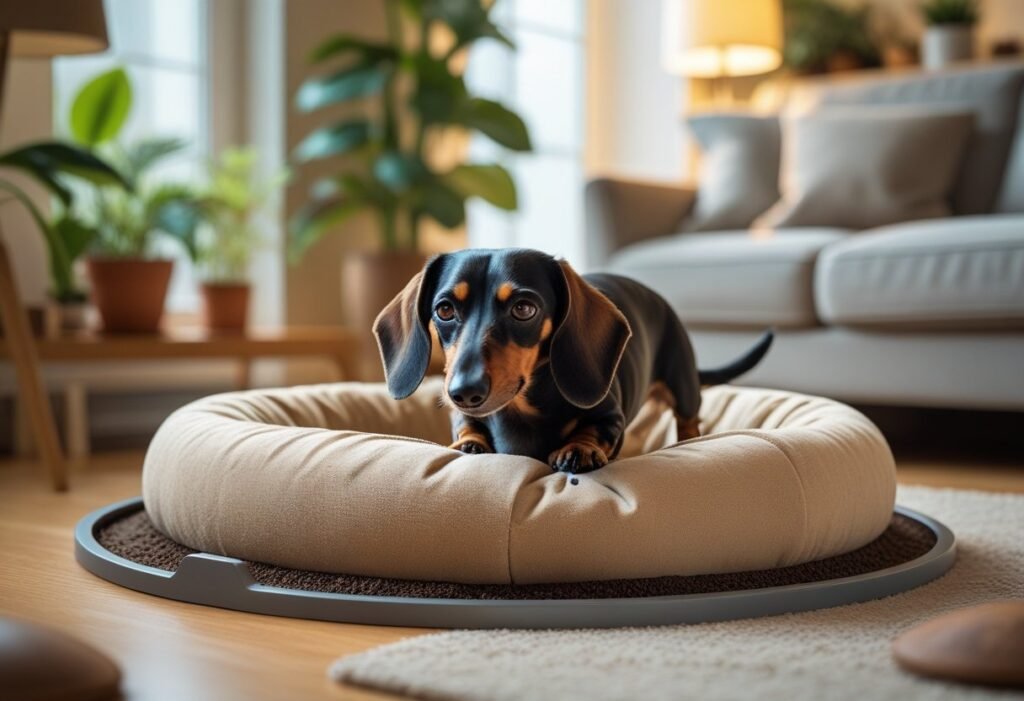
Dachshunds really do need a way to work out those digging instincts 🐾. The right setup lets them burrow to their heart’s content and keeps your home safe from their little excavations 🏡.
Specialized Burrowing Beds and Blankets 🛏️
Several pet companies now make beds just for burrowing dogs 🐶. Look for “burrow beds” or “cave beds” with built-in covers so your dachshund can tunnel inside 🕳️.
These beds usually have a soft, plush opening and a covered area that feels like a cozy den 🌙. Snuggle sacks and burrowing blankets work well for dachshunds too 🛋️.
These blankets have pocket-like openings where your dog can crawl in and get comfy 😌. Many are machine washable and come in all sorts of sizes 🧺.
Think about temperature when picking out beds 🌡️. Some models use cooling materials for hot days ☀️, while others add extra warmth for winter ❄️.
For even more comfort, try beds with orthopedic foam bases 💪. These support your dachshund’s long back while they burrow and snooze 💤.

🛏️ Majestic Pet Orthopedic Bed
- Orthopedic support helps long backs relax instead of pacing or digging 💤
- Bolstered sides create a den-like feel that satisfies nesting urges 🐾
- Defined “spot” teaches your Doxie where to settle during quiet times 🏡

🌿 Zomalka Anxiety Relief Drops
- Helps ease stress so compulsive burrowing is less likely 🙂
- Useful during storms, alone time, and training transitions ✅
- Pairs well with dig boxes and calm routines for better results 🔄
DIY Burrowing Spaces 🧵
Homemade burrowing spots can save money and still work great 💡. Start with a sturdy box and cut an entry hole just big enough for your dachshund 📦.
Line the box with soft blankets or towels to make it inviting 🪄. You can also make a “blanket nest” by piling up blankets in a basket or a corner 🛒.

🎉 Grab your free Dachshund care checklist!
Fold the blankets to create natural tunnels and pockets for your dog to explore 🔎. Old pillowcases partly filled with soft materials make fun tunnel systems too 🛏️.
Lay out several pillowcases together and connect them for a longer burrowing adventure ➰. The “towel mountain” trick works as well—stack towels or small blankets and let your dachshund rearrange them however they like 🏔️.
Innovative Indoor and Outdoor Setups 🌟
Indoor tunnel systems made for kids can double as dachshund play spaces 🎠. Collapsible play tunnels are easy to set up during playtime and stash away later 📥.
Set up a digging area in your yard with a sandbox full of clean play sand 🏖️. Hide toys or treats to encourage digging in the right place 🎾.
Some people build “burrow zones” under decks or porches with loose, safe materials for digging 🪴. Just make sure these spots are escape-proof 🔒.
“Snuffle mats” are worth a try too 🧩—these textured mats have fabric strips where you can hide treats 🍪. They let your dachshund forage without making a mess 🧹.
If you want flexibility, use portable dig boxes that move between indoors and outdoors depending on weather or your mood 🌦️.
Accessorizing for Comfort and Safety

Giving your dachshund the right accessories can help manage their burrowing and keep them comfy and safe 🐾. Plus, who doesn’t want their pup looking stylish? ✨
Best Cute Doxie Accessories for Burrowing 🎀
Dachshund-specific accessories can satisfy your dog’s urge to burrow and protect your home at the same time 🏡. Try a dachshund burrow bed with attached blanket flaps so your pup can tunnel inside 🛏️.
These beds mimic the cozy dens doxies love 🌙. Snuggle sacks are another great pick—these soft, pouch-like beds let your dachshund crawl in completely 🐶.
Go for machine-washable versions with non-slip bottoms for easy cleaning and safety 🧼. If your dog is an active burrower, puzzle toys can redirect their energy in a fun way 🧩.
Toys with hidden treat compartments offer mental stimulation as your pup digs for rewards 🍪. Dachshund-specific tunnels are also a hit—these fabric tubes give your dog a safe spot to dig and play 🎠.
Choose tunnels with reinforced sides so they don’t collapse mid-play 💪.
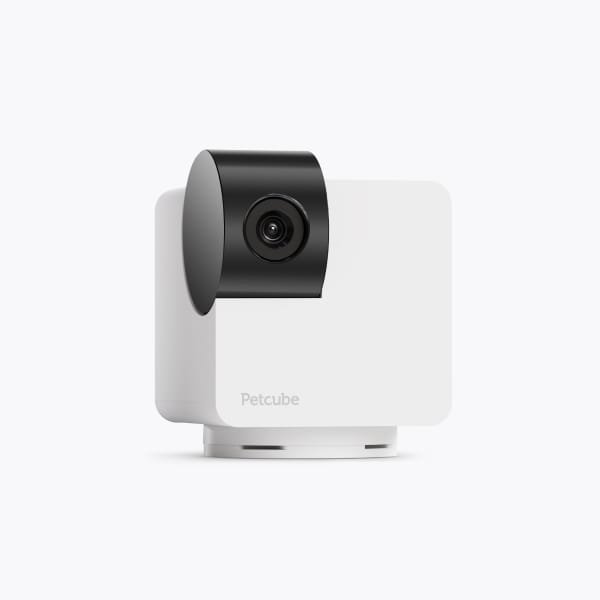
📹 Petcube Cam 360
- 360° view lets you spot pre-dig signs and redirect in real time 👀
- Two-way audio to reassure and guide your Doxie to their dig box 🎤
- Night vision for peaceful evenings without couch “excavations” 🌙
📍 Tractive Dog GPS Tracker
- Live GPS helps recover curious diggers fast if they slip the yard 🚀
- Set “no-dig” boundary alerts along fence lines for quick action 🔔
- Activity insights help plan exercise to reduce restless digging 📈
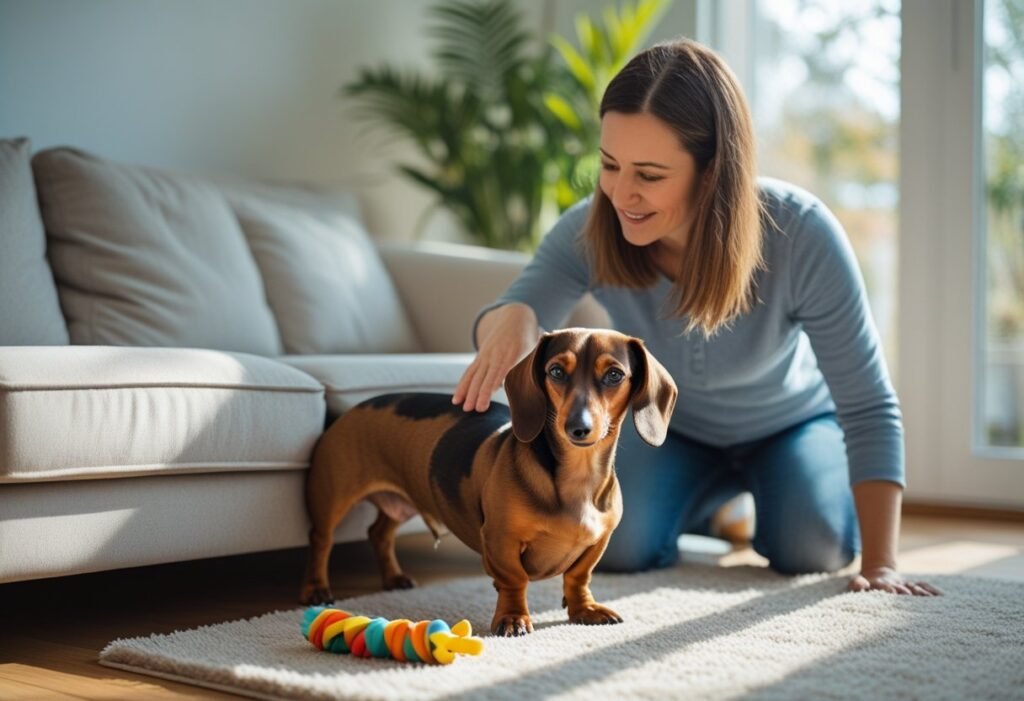
Choosing the Right Dachshund Sweaters and Coats 🧥
Dachshunds have short coats and long bodies, so they get cold easily ❄️. Good outerwear is a must for chilly walks or outdoor digging 🚶.
Pick sweaters that cover the belly area completely 👕. This keeps your doxie warm when they’re close to the ground or rooting around outside 🌱.
Measurements matter more than size labels 📏. Measure your dog’s:
- Length (neck to tail base) 📐
- Chest circumference 🐕
- Neck circumference 🔄
Pick materials based on how active your dog is 🏃. Lightweight fleece works indoors, while waterproof coats are better for wet or muddy digging sessions outside 🌧️.
Avoid clothes with loose parts that could snag while burrowing 🚫. Go for secure fasteners like Velcro that stay put even during wild play 🔒.
Training Tips for Lasting Results

Breaking a dachshund’s burrowing habit takes consistent training and a bit of patience 🐾. The right approach respects your dog’s instincts while helping them adapt to your home 🏡.
Consistency and Patience 🕰️
Training your dachshund to stop unwanted burrowing isn’t instant ⏳. Stay consistent with your commands and corrections every time you spot the behavior 👀.
Use a firm but gentle “no” if you catch them digging where they shouldn’t 🙅. Right away, guide them to an approved activity or digging spot 🎾.
This kind of positive redirection works much better than punishment ✅. Here’s a quick rundown for rewards:
- Praise your dog right away when they dig in the right spot 🎉
- Give small treats when they follow your lead 🦴
- Stick with the same verbal cues so your dog knows what you mean 📢
Keep training sessions short—about 5-10 minutes is plenty for most dachshunds ⏱️. Their attention spans are pretty short, so a few quick sessions a day beat one long one 🔄.
Progress can be slow 🐢. Some dachshunds might need weeks or even months before the habit fades, so hang in there 💪.
🏡 Smart Solutions to Curb Burrowing & Encourage Calm Behavior
- 💧 Petlibro Water Fountain — Keep your Dachshund hydrated and relaxed; proper hydration can reduce anxious digging tendencies.
- 🍖 Petcube Bites 2 — Reward calm, non-digging behavior instantly to redirect burrowing instincts into positive habits.
- 🪜 Majestic Pet Stairs — Offer cozy, elevated access to beds or couches to reduce the urge to dig for comfort or nesting.
- 🧬 AnimalBiome Gut Health Test Kit — Identify gut imbalances that can lead to stress-related digging or obsessive behaviors.
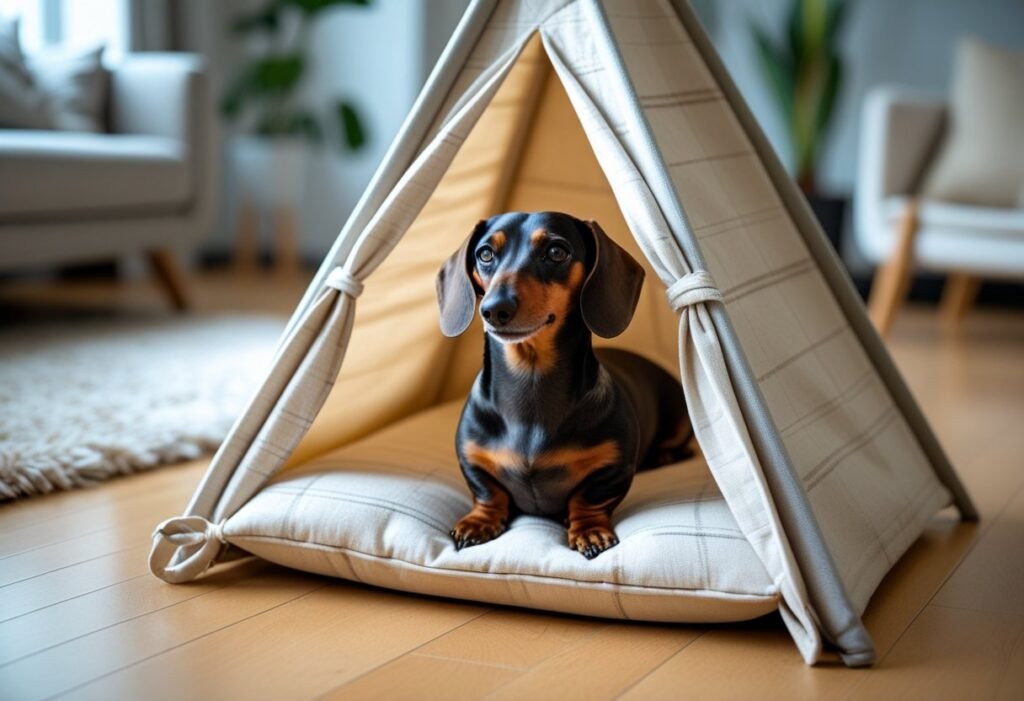
When to Seek Professional Help 👩🏫
If your dachshund’s burrowing turns destructive or obsessive, and training doesn’t help, it might be time for outside help 🚨. Watch for frantic digging that you can’t stop or damage to your stuff 🛋️.
A certified dog trainer who knows hunting breeds can create a custom plan for your doxie 🎯. They get the unique challenges dachshunds bring 🐕.
Consider professional help when:
- Your dachshund keeps damaging furniture 🪑
- The digging gets worse even with training 📉
- Your dog looks anxious or stressed while digging 😟
- Burrowing starts affecting your pup’s quality of life ❤️
Behavioral pros might suggest desensitization or counter-conditioning 🔄. These methods go after the root causes of all that digging 🧩.
Ask your vet for trainer recommendations 🩺. Sometimes, medical issues cause burrowing problems, and you’ll want to address those first ✅.
Maintaining a Happy, Healthy Doxie

Dachshunds do best when you respect their instincts but set boundaries that work for your home 🐾. It’s a balancing act, but it keeps your doxie happy and out of trouble 😊.
Balancing Instinct and Household Harmony ⚖️
Set up digging areas where your dachshund can safely let loose 🏖️. A sandbox in the yard or a dig box with soil and hidden toys works for these little hunters 🎾.
When you catch your doxie digging where they shouldn’t, calmly interrupt and guide them to their own digging spot 🚫. Clear boundaries help everyone ✅.
Make sure your dog gets enough physical exercise—aim for at least 30-60 minutes a day ⏱️. Walks, playtime, and supervised yard time burn off energy that might otherwise fuel destructive digging 🚶.
Don’t forget mental workouts 🧩. Puzzle toys, snuffle mats, and training sessions keep your dachshund’s brain busy, which helps with behavior, too 🧠.
💛 Calm & Comfort Essentials to Redirect Digging Behavior
- 🎽 Embark Pet Adventure Harness – Provide structured outdoor walks to release energy, reducing your Dachshund’s urge to dig indoors
- 🧴 Pride + Groom Grooming Tools Kit – Gentle brushing promotes relaxation and replaces restless digging with calm bonding time
- 🫧 King Klean Dog Shampoo – Soothing, fresh baths help your Dachshund unwind and feel cozy—less stress, less digging
- 🎨 Purr & Mutt Personalized Dachshund Art – Add a touch of calm beauty to your home décor while celebrating your Doxie’s personality
- 👕 Dog is Good Apparel & Gifts – Spread positive vibes and stay inspired as you guide your pup away from digging habits
🐾 Redirect that digging instinct with calm routines, soothing care, and positive daily engagement—your Dachshund will thank you!

Monitoring Mental and Physical Health 🩺
Watch out for excessive digging—it can mean your dog’s bored, anxious, or stressed 😟. If digging suddenly ramps up, think about any recent changes at home 🏡.
Protect their long backs by stopping them from jumping on and off furniture 🪑. Ramps for beds and couches can really help prevent back injuries 🛠️.
Book regular vet check-ups to monitor weight and back health ⚕️. Obesity is a big risk for dachshunds and can make digging worse if they’re uncomfortable ⚖️.
Check their paws often for injuries from digging 🐾. Look for cracked pads, broken nails, or anything stuck that could hurt 🩹. Give lots of praise and treats when your dachshund behaves well 🎉. It really does help strengthen your bond ❤️.
🐾 Don’t Miss Out!
Download our free Dachshund care guide to keep your furry friend happy and healthy.
Get Your Free Guide 🐶Frequently Asked Questions
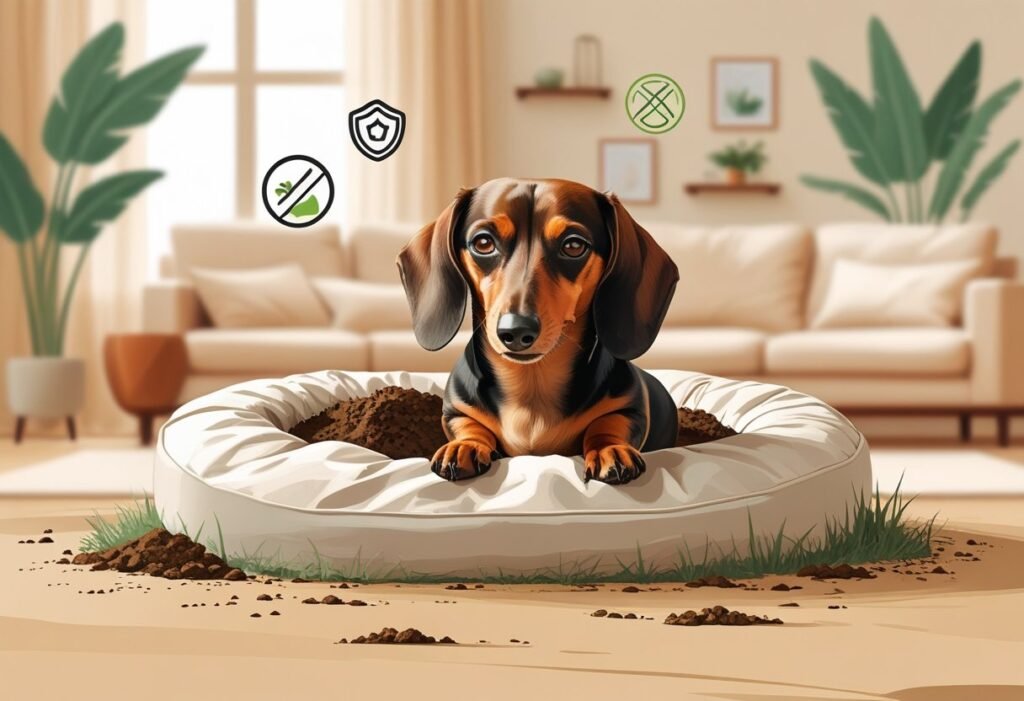
Dachshund owners often wrestle with their pet’s digging habits 🐾. Here are some common questions and practical solutions to help you and your dog live happily together 🏡.
How can I prevent my Dachshund from digging in the house? 🛋️
Offer plenty of appropriate toys to redirect your dachshund’s energy 🎾. Puzzle toys and treat-dispensing options keep their minds working and paws busy 🧩.
Make sure your dog gets enough exercise 🚶. A tired dachshund is way less likely to dig up your carpet or furniture 🛑.
Create digging zones with blankets or special beds in quiet corners where your dog feels safe 🛏️. If you need extra help, try bitter apple spray on areas you want to protect—the taste is unpleasant but harmless 🍏.
What are the best ways to satisfy a Dachshund’s burrowing instincts? 🕳️
Get a cave-style bed so your dachshund can burrow safely 🐶. These beds have covers or hoods that let them tunnel just like they want 🛌.
Make a blanket nest for your dog to dig and arrange to their liking 🪄. Soft fleece blankets are a favorite for this ❄️.
Try a sandbox in a contained part of your yard for a dedicated digging spot 🏖️. Rotate new toys often to keep your dachshund interested—stuffed toys they can “hunt” and burrow with are always a hit 🦴.
Are there effective training methods to curb a Dachshund’s digging behavior? 🎓
Use positive reinforcement when your dachshund chooses the right digging spots ✅. Treats and praise right after good behavior go a long way 🎉.
Try the “redirect and reward” method 🔄. When you catch your dog digging where they shouldn’t, calmly move them to a better spot 🌱.
Clicker training helps mark the exact behaviors you want 🖱️. Consistency is key—everyone in the house should use the same rules to avoid mixed signals 🗝️.
What are safe alternatives to outdoor digging for Dachshunds? 🌟
Snuffle mats offer mental stimulation and satisfy foraging instincts 🧩. These mats have fabric pockets to hide treats for your dog to find 🍪.
Set up a simple indoor agility course with tunnels and low jumps 🏃. Dachshunds love the activity, and it burns off excess energy 💨.
Hide treats around your home for your dachshund to “hunt” 🔍. Food puzzle toys that require problem-solving also keep them busy and happy 🥳.
How can I protect my yard and garden from my Dachshund’s burrowing habits? 🌱
Set up a digging spot just for your dog in one part of the yard 🏖️. You could use a child’s sandbox or build a little area with landscape timbers and fill it with soft, loose dirt 🌿.
Put up some physical barriers around your flower beds or vegetable gardens 🌸. Low decorative fencing helps, or you can try lining the edges with big rocks—they’re surprisingly effective 🪨.
Try using pet-safe deterrents where you don’t want your Dachshund to dig 🚫. Some folks go for commercial repellents, but honestly, tossing down some citrus peels might do the trick too 🍋.
Keep an eye on your pup during outdoor time 👀, at least until they pick up better habits ✅. That way, you can step in and redirect them right away if they’re about to start digging where they shouldn’t 🐕.
What products are available to manage a Dachshund’s natural burrowing tendencies? 🛒
Burrow beds with hoods or covers give Dachshunds a safe place to tunnel 🛏️. Many of these beds use soft, washable fabrics that dogs seem to love 🧺.
Dig boxes made just for dogs create a contained space for digging 📦. You can set them up indoors or even on a patio if you live in an apartment 🌇.
Treat-dispensing toys offer mental stimulation 🎾. Choose ones that make your dog work a little to get the treats out, so their paws and brain stay busy 🧠.
Some Dachshunds dig because they’re stressed 😟, which is tough to watch 💔. Anti-anxiety wraps apply gentle pressure that can help soothe nervous pups and sometimes cut down on that compulsive digging 🛡️.

